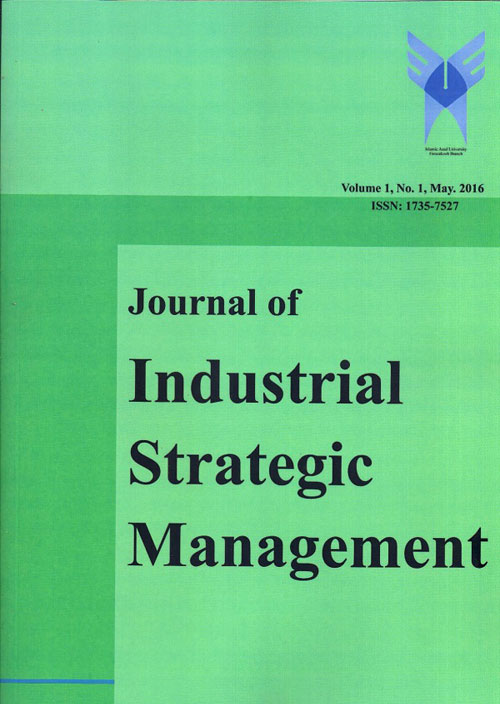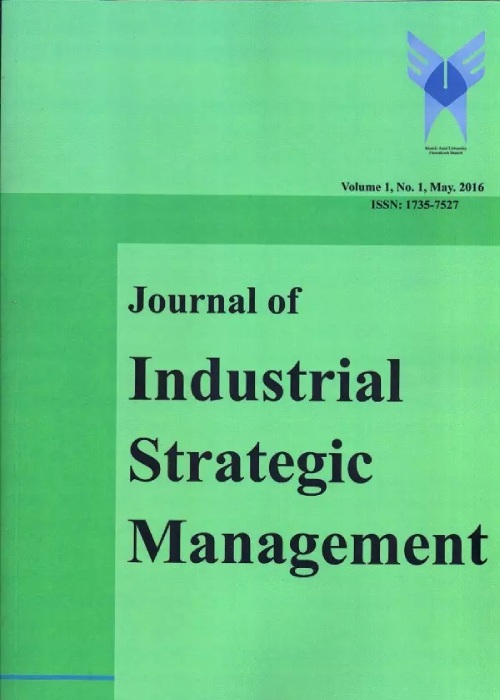فهرست مطالب

Journal of Industrial Strategic Management
Volume:6 Issue: 3, Summer 2021
- تاریخ انتشار: 1400/12/04
- تعداد عناوین: 7
-
Pages 1-26
The present study is presented in order to determine the optimal investment portfolios between a bank and its customers, in the form of a two-level game by Stackelberg (leader-follower). The game is based on the Markowitz mean-variance model. Leader player portfolios (Bank 3) have included deposit portfolios in rival banks (Banks 1 and 2), investment in the real estate market, investment in the stock market and investment in the foreign exchange market. Also follower player portfolios (Bank 3 customers), including deposits in rival Banks(1,2), investment in the coin and gold market, investment in the foreign exchange market, investment in the housing and real estate market, investment in the car market, investment in the stock market. The data related to the mentioned assets covered 2009-2017, where the optimal investment portfolios of the players was first determined using GAMS software. Next, the problem was solved again using the meta-heuristic algorithm of Firefly in Matlab Software. Eventually, the optimal technique was chosen. Finally, the results of the study showed that the optimal investment portfolios for the leader player include investing in the real estate market and investing in the stock market, respectively. Also, the optimal investment portfolios of the following player include depositing in Bank 2, investing in the coin and gold market, investing in the stock market and investing in the real estate market, respectively.
Keywords: bi-level game, investment portfolio, Markowitz model, Firefly Algorithm, Iranian banking network -
Pages 27-44
Given the importance of education and institutionalization of the relevant discussions in scientific centers and universities, this article was to identify environmental strategies for managing human resources in the Islamic Azad University, Iran. This is an applied research in terms of purpose, a correlation study in terms of descriptive nature, and a survey in terms of method. The statistical population included experts of human resource management from the Islamic Azad universities. The researcher-made questionnaire consisted of 31 questions in the spectrum of very high to very low was used to collect data. The methods proposed by (Hui Law & Chen, 2017) were used to determine the content validity. Validity of the measurement tool was checked referring to the experts' opinions. The questionnaire was given to the experts to match the questions to the variables using three options of "necessary", "useful but not necessary" and "not necessary". An acceptable lavage coefficient of 0.42 was obtained for 20 experts. In addition, more than 70% of the respondents selected the option "appropriate" as the lavage option for all items, and the lavage coefficient of above 0.42 was obtained for all the items, and finally, their validity was confirmed. The Content Validity Index (CVI) was calculated to be 0.99 in most cases. Cronbach's alpha coefficient of the variables was higher than 0.7, indicating the internal consistency of the items and confirmation of reliability. In this article, 31 environmental strategies were presented for managing human resources as 4 general loops of recruitment and employment, education.
Keywords: Sustainable Development, Human Resources, Environmental Strategies, Green Management, Scientific Centers, Universities -
Pages 45-58
Virtual social networks are a modern age of spaces that play an important role in the world today. They are highly dynamic networks with a complex structure. This is why it is very difficult to predict communication in this field. The prediction has recently caught the attention of various researchers as one of the most important aspects of data mining. In addition to understanding the relationship between groups in social communities, the connection prediction in social networks also ensures that networks are popular. Link prediction is the prediction of the probability that two entities will interact based on some unique and common characteristics between them. Link prediction is intended to generate and propose a list of persons to whom the user communicates. This study introduces a prediction approach used to combine a genetic algorithm with an algorithm from Louvain. Data are first chosen from the default dataset as binary in this process. Then the best nodes are extracted and chosen based on merit using the genetic algorithm. Lastly, the modularity of the networks is obtained by using the Louvain algorithm. The findings indicated the optimal performance of this approach.
Keywords: Link Prediction, Social networks, Genetic Algorithm, Louvain Algorithm -
Pages 59-67Voluntary disclosure of corporate information is a mechanism to reduce information asymmetry between managers and people outside the organization, reducing agency costs and improving reports’ transparency. The present study investigated the impact between expertise and audit committee size on voluntary disclosure of information between 2013 and 2015 in Tehran Stock Exchange companies. A list of voluntary disclosure cases was prepared for measuring the amount of voluntary disclosure of information in the annual report by studying and reviewing the accounting standards and laws applicable to information reporting and the Botosan checklist. The size and expertise of the audit committee are the audit committee’s features. To test the possible association between the amount of voluntary disclosure of information and these characteristics of the audit committee, analysis and correlation were done on 81 companies listed on the Tehran Stock Exchange during three years. Furthermore, after data collection using the Systematic Removal Method, the research hypotheses were tested using a cross-sectional regression model and Eviews Software. The results reveal that only the audit committee’s size positively and significantly affects the voluntary disclosure of information. Also, no significant effect was observed between the expertise and voluntary disclosure.Keywords: Audit Committee, Committee size, Committee expertise, voluntary disclosure of information
-
Pages 68-86The increase in the elderly population in the country and the basic need for health products is an issue that is less considered by humanities experts and more in the field of medical sciences. Perhaps because for us, treatment has always been prior to prevention; Not prevention to cure! The purpose of this study is to introduce new methods of marketing health products for the elderly in order to increase the desire to consume health products among this group and reduce their per capita medical costs. Research Methods; Survey and step by step and data collection tools; Interviews and questionnaires are open and closed. The research study community is Army retried (AJA) with more than 260,000 elderly retirees. Direct staffs of various departments (all of whom are senior officers) were identified as research experts and the required information was collected during 5 stages of interviews and questionnaires from experts. Finally, 10 marketing methods for health products related to the elderly community through The Weighted Aggregates Sum Product Assessment (WASPAS) model in Excel software are prioritized and presented as a model for performance. Vertical marketing with 0.825, Word of mouth marketing with 0.787, Information marketing with 0.783, behavioral marketing with 0.770, Newspaper marketing with 0.647, One to one marketing with 0.584, Scientific marketing with 0.566, Catalog Marketing with 0.546, Traditional marketing with 0.533 and finally Analytical marketing with 0.416 Index with λ = 0.5; are the most effective methods of marketing health products in the elderly community of the country.Keywords: Marketing Knowledge, Marketing Methods, Health Products, Elderly Community
-
Pages 87-98Today, the role of industrial clusters as a spatial representation of small and medium industries in providing development in its general sense, both in less developed countries and in more developed countries, is not hidden from anyone because industrial clusters are the location of industries. Small and medium appear in relation to each other and together in a geographical context, due to having wide horizontal and vertical links, provide a high level of productivity and efficiency for business formation. The purpose of this study is to prioritize the factors affecting the development of industrial clusters in small and medium industries. The method used in this research is Analytic network process.The statistical population of the present study is the experts of industrial clusters. Finally, spatial factors were in the first place and policy factors were in the second place and economic factors were in the third place finally practical suggestions were providedKeywords: Industrial cluster, Industrial Town, decision making, small, medium industry
-
Pages 99-121Sustainable supply chain management develops the business, environmental and social dimensions. In this regard, the use of blockchain in the sustainable supply chain provides a platform for secure data exchange and protects documents and events against fraud and manipulation in the process of transportation. The aim of this study was to identify the factors affecting blockchain technology in sustainable supply chain of Mobarakeh Steel Company. Using the Delphi technique, factors have identified with the maximum agreement of experts, in-depth study of previous studies, judgments of respected professors and experts in the field of management, and experts working in Mobarakeh Steel Industry. The factors were analyzed using SPCA and KPCA methods. The research methodology is a descriptive/ correlational survey, data were collected in terms of practical research, and library research has been in compiling the theoretical foundations and related literature. The statistical population of this study includes 74 experts in the field of sustainable supply chain, and finally, the opinions of 56 experts have been analyzed. A researcher-made questionnaire was used to collect data and the content and face validity of the questionnaire was confirmed by experts. The reliability of the questionnaire was confirmed with Cronbach’s alpha = 0.961. Statistical data were analyzed in SPSS and R software and SPCA and KPCA methods were implemented. The results showed that the identified factors in three general dimensions are business, social and environmental, respectively, which are affecting blockchain technology in the sustainable supply chain of Mobarakeh Steel Company.Keywords: Blockchain, sustainable supply chain, Business, Social, Environmental


